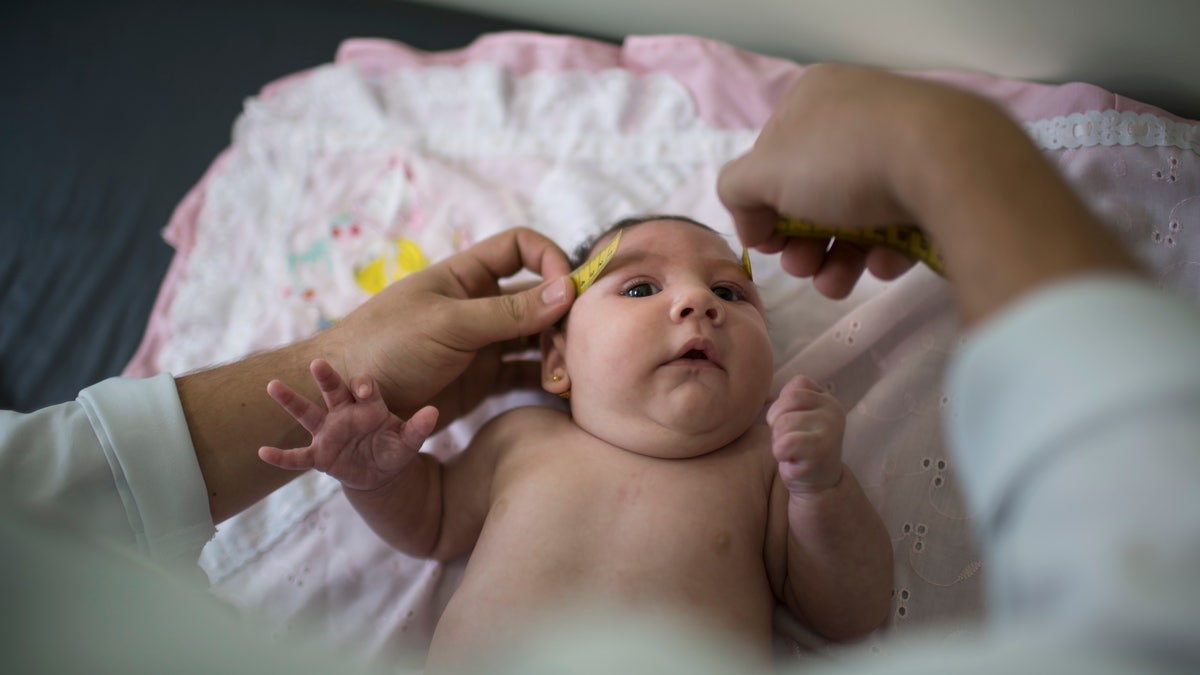
In this Dec. 22, 2015 photo, Luiza has her head measured by a neurologist at the Mestre Vitalino Hospital in Caruaru, Pernambuco state, Brazil. Luiza was born in October with a head that was just 11.4 inches (29 centimeters) in diameter, more than an inch (3 centimeters) below the range defined as healthy by doctors. Her rare condition, known as microcephaly, often results in mental retardation. (AP Photo/Felipe Dana)
I remain very critical of the Centers for Disease Control and Prevention (CDC) and its director, Dr. Tom Frieden. During the Ebola outbreak, the cases in Africa reached the thousands before Americans were informed about what the virus even was, and how they should act to protect themselves. Given the current outbreak of the Zika virus and the lack of urgency from the CDC, I can confidently conclude that little, if anything at all, was learned from the Ebola crisis.
The Zika virus is transmitted by the Aedes aegypti mosquito, which is also a vector for dengue fever and chikungunya, and can be found in the U.S. While symptoms of Zika can present as fever, rash, joint pain and red eyes, more than 80 percent of patients are have no symptoms at all. Currently, the only prevention for the virus is insect repellent and covering exposed areas of skin. However, once a patient is infected, there is no treatment.
What is frightening about the virus is that it has been linked to a rise in babies born with microcephaly, a neurological disorder in which infants are born with smaller craniums and brains. The condition can lead to a range of neurological issues like mental retardation or cognitive delay. As of last week, the number of cases in Brazil alone had reached nearly 4,000 since the first case in May 2015. In addition to microcephaly, health officials in two Latin American countries are investigating whether Zika is behind the rise in number of cases of Guillian-Barre syndrome, a rare, and sometimes life-threatening condition that attacks the immune system. The condition can affect anyone of any age, and causes muscle weakness that can last for several weeks or months. The severely debilitating disease may even attack patients’ ability to breathe, causing them to eventually be placed on life support.
The Zika virus’ stronghold in Brazil, the Caribbean and other Latin American countries did not appear overnight, but it took confirmed cases in the U.S. for the CDC to react. On Friday, the CDC advised pregnant women to reconsider travel to 22 countries dealing with Zika outbreaks. Then they issued guidelines instructing doctors to administer blood tests for pregnant women who had traveled to afflicted areas and presented symptoms. For the 80 percent of patients who are asymptomatic, the agency recommended ultrasounds at 24 weeks to check for microcephaly in the fetus. Remember, there is no treatment for Zika once it is detected. A blood test can result in a false positive, or fail to detect the virus at all. And in many states, abortion is considered illegal after 24 weeks of pregnancy. Do you see where I am headed?
My issue with the CDC is this: With more than 4,000 cases of microcephaly in Brazil, and thousands more in Latin America and the Caribbean, why did it take so long for the CDC to warn the travel-friendly American public? Americans favor Latin America and the Caribbean for vacations immensely, and the phenomena of expectant parents embarking on a relaxing beach “baby-moon” is not a passing trend. I am shocked that Dr. Frieden once again failed to act in the face of an outbreak. For many, these so-called guidelines may be too little, too late.
In addition to the failed attempt at prevention, the CDC is not acting with a sense of urgency that this outbreak requires. The guidelines are being slowly circulated, and the topic of Zika remains foreign to many Americans. There is also little being said about what happens once Zika is detected in an expectant mother. The CDC must be more vigilant in addressing congenital abnormalities so that patients and expectant mothers can understand the severity of the virus. They must also have a more aggressive policy toward mosquito control, and educate the public on what to look for to prevent mosquito infestations.
In all countries where Zika is rampant, the health ministries are educating the public and working to check bodies of standing water for the virus. They are fumigating areas where the virus has been found, and urging expectant mothers to use insect repellant and cover exposed areas of skin. The CDC is not being public enough with their warnings or plans for prevention. It seems as though the hysteria over Ebola and possible cases in the U.S. has been long-forgotten. With the current lack of leadership and urgency, the Zika crisis could have the potential to reach epic heights in the U.S., where an outbreak such as this should be completely avoidable. I am urging Dr. Frieden to step up and issue stronger warnings to pregnant Americans. As the old adage goes, “An ounce of prevention is worth a pound of cure.”
